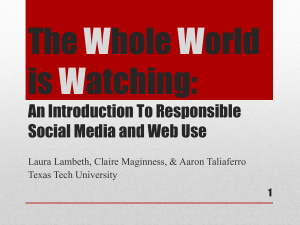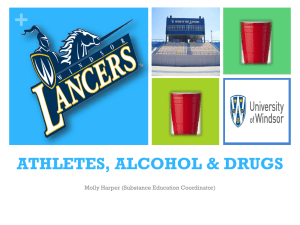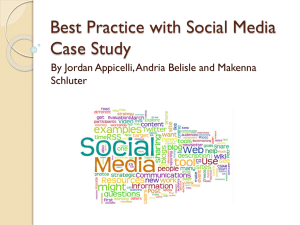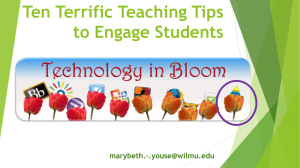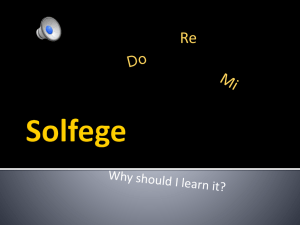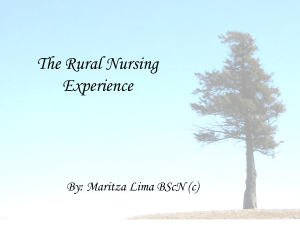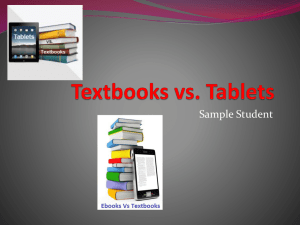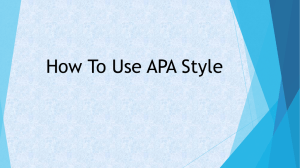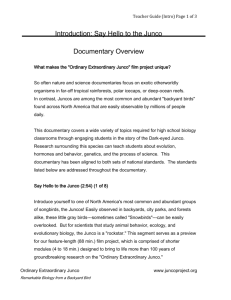Florida State University
advertisement
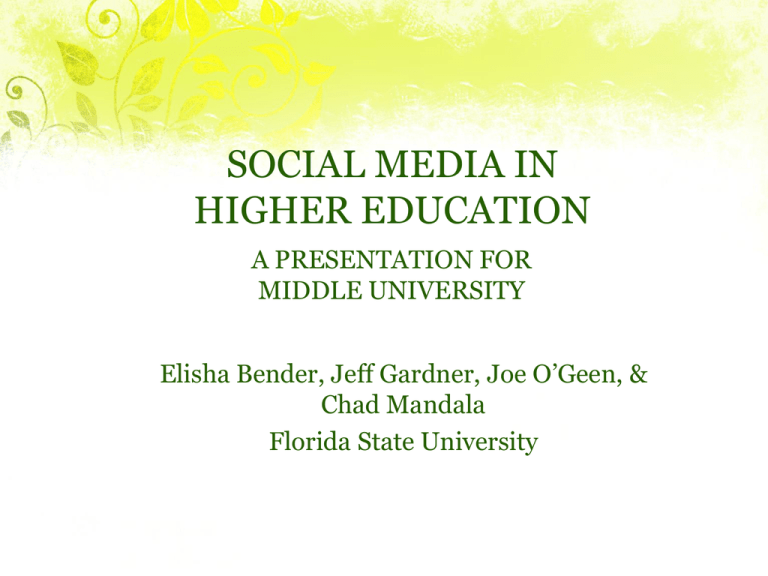
SOCIAL MEDIA IN HIGHER EDUCATION A PRESENTATION FOR MIDDLE UNIVERSITY Elisha Bender, Jeff Gardner, Joe O’Geen, & Chad Mandala Florida State University “Saying young people have become reliant on social media is kind of like saying young people have become reliant on communicating with peers, being inquisitive, forming communities and experimenting. Young people have always done those things, and social media is just the latest in a long tradition of technological advances that young people have embraced.” - Association for Social Media & Higher Education Benefits of Social Media • Students value social media, in fact 74% of students think that schools should have a presence on social media sites (Noel, Levitz, 2010). • Social media can be used to create dynamic, relevant communities (Munoz, Strotmeyer, 2010). – Students report higher levels of interaction with faculty members and greater comfort communicating with others (Junco, Mastrodicasa, 2007). • Social media makes it easy to reconnect with alumni – Florida State University used social media successfully in its online fundraising campaign The Great Give (FSU, 2012). Benefits Continued • Students engaged in social media sites are more engaged in campus organizations (Heiberger & Harper, 2008). • Using social media is a free, easy way to publicize campus events (Rueben) • Using Twitter in educationally relevant ways in a first-year seminar course increased student engagement and improved grades (Junco, Heiberger & Loken, 2011). • Social media can be used for an admissions office to connect with prospective students Challenges of Social Media • It is difficult to assess the effectiveness of social media marketing strategies (Munoz, Strotmeyer, 2010). • Implementing the right social media strategy for your campus can be challenging, as it is important to consider the needs of the student population (Munoz, Strotmeyer, 2010). • If the university does not have adequate moderation, social media does not give administrators as much control over messages that are being delivered. • Maintaining a sufficient social media presence requires a significant time commitment • Building a consistent brand can be difficult (Jadu, 2010). • Nonverbal communication is limited (Junco & Chickering, 2010). LEGAL CONSIDERATIONS First Amendment Issues • Middle University is a private institution – Bound by the standards of contract law • We must uphold the promises and guarantees made to students via brochures, handbooks, and advertising • Can restrict what individuals say in university controlled media and forums • We intend to have the social media “home base” moderated by an administrator • Moderating allows people to submit comments and viewpoints, while we are able to institutionally control content seen by the public. Know Your Rights & Obligations • First Amendment Rights – As a citizen of the United States, the right to free speech is a protected constitutional right – However, protection of free speech excludes “fighting words, true threats, incitement, obscenity, and defamation” (Fossey, Melear, & Beckham, 2011, p.290). • Conversely as a students and faculty of Middle University, it is your obligation to uphold the student code of conduct – “Student conduct codes are guidelines set forth by colleges and universities in an effort to maintain a safe, yet productive, campus environment” (Beckstrom, 2008, p. 271) • Be aware of your rights, but remember that you are also representing Middle University Things to Consider • MU’s Federal District Court’s decisions on private school limitations on free speech – We are legally obligated to uphold the rulings of our Federal District Courts; however, we should look to the decisions of other Federal District Courts for guidance on issues our specific district may have yet to address via case law. • State specific legislation that governs MU as a private school – We must be cognizant of the impacts of state specific laws • Such as California’s “Leonard Law” which states institutions of higher education must afford students their First Amendment rights regardless of institutional type • Ensuring imposed restrictions are content neutral – Our restrictions should focus on the time, place, and manner of speech, not on the content of the speech itself. Civility Concerns • Civility Issues: – A number of studies have found students are coming to college from environments that are increasingly uncivil – Electronic forums have provided new outlets for constant contact with individuals – Adults are fostering these uncivil environments through their behaviors Social Media as a Limited Forum • Social media endorsed by the university falls under the classification of a limited forum: • “Classrooms, libraries, lecture halls, theaters, laboratories, and even Internet platforms are typically set aside on the public institution’s campus for educational purposes, and judges consistently apply analysis associated with a non-public forum to these settings” (Fossey, Melear, & Beckham, 2011, p.291). • Additionally: “When the venue serves an additional purpose that is closely aligned with its educational mission, the institution may properly assert that its primary use is incompatible with extending free speech protections….” (Fossey, Melear, & Beckham, 2011, p.291) • A limited forum implies that particular speech within the forum is held to a greater standard by the university and may be restricted • It is also important to remember that as a private institution, a greater emphasis is placed on limited forums and speech • When utilizing social media outlets that are supported by Middle University it is important to exercise a greater degree of care when publishing content What can we do? • • • • Promote responsible use of social media Encourage in person conflict mediation Provide resources on healthy communication Challenge students to be cognizant of how their behavior impacts their community At Middle University • We will offer a Do’s and Don’ts guide to social media to inform MU students of our expectations of their behavior and provide guidance on how to maximize their social media experience • Offices will have a social media presence as a means of outreach and providing positive social media role models for students TIPS FOR STUDENTS Here are some Do’s and Don’ts of social media, to help the President of Middle University ensure students understand the long-term risks of putting too much information on the Internet Please click to watch BEST PRACTICES There are many great ways that social media is currently being used on college campuses. This section of our presentation highlights several institutions that also provide an example of how social media would be beneficial at Middle University. Unleash the Possibilities Engage Current & Prospective Students Involve Faculty Partner with Student Organizations References • • • • • • • • http://joesabado.com/2011/08/sm-general-resources/ American University. (2012). AU social media club. Retrieved from http://ausmcedu.org/ Beckstrom, D. C. (2008). Who’s looking at your facebook profile? the use of student conduct codes to censor college students’ online speech. Williamette Law Review, 45(2), 261. Chickering, A. W., & Junco, R. (2010). Civil discourse in the age of social media. About Campus. Retrieved from http://onlinelibrary.wiley.com Duke Alumni Association. (2010). Office hours. Retrieved from http://dukealumni.com/learn-travel/office-hours Fossey, R., Melear, K. B., & J.C. Beckham (Eds.). (2011). Contemporary issues in higher education law (2nd ed.). Dayton, Ohio: Education Law Association. Heiberger, G. Harper, R. (2008). Have you facebooked Astin lately? Using technology to increase student involvement. New Directions for Student Services, 2008(128), 19-35. Ithaca College. (2012). myIthaca. Retrieved from https://my.ithaca.edu/ References Continued • • • • • • • Junco, R., Heibergert, G., & Loken, E. (2011). The effect of Twitter on college student engagement and grades. Journal of Computer Assisted Learning, 27(2), 119-123. Lipka, S. (2009, May 1). Colleges using technology to recruit students try to hang on to the conversation. The Chronicle of Higher Education. Retrieved from http://www.chronicle.com. Munoz, F. M., & Strotmeyer, K. C. (2010). Demistifying social media. Journal of Student Affairs Research and Practice, 47(1), 123-127. Noel-Levitz, Inc. (2011). 2011 E-Expectations Report: The online expectations of perspective college students and their parents. Retrieved from: http://www.noellevitz.com Rueben, R. (2008). The use of social media in higher education for marketing and communications: A guide for professionals in higher education. Retrieved from: http://www.doteduguru.com University of Delaware. (2012). UD social media. Retrieved from http://www.udel.edu/socialmedia/ Yagelski, R. P., & Miller, R. K. (2010). The Informed Argument (8th ed., pp. 351-357). Belmont, MA: Wadsworth. Retrieved February 15, 2012
